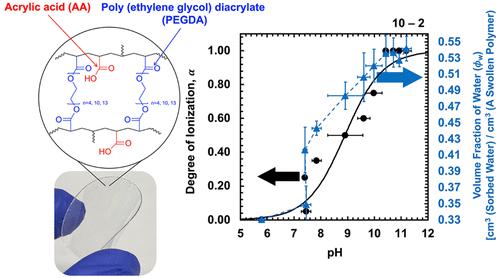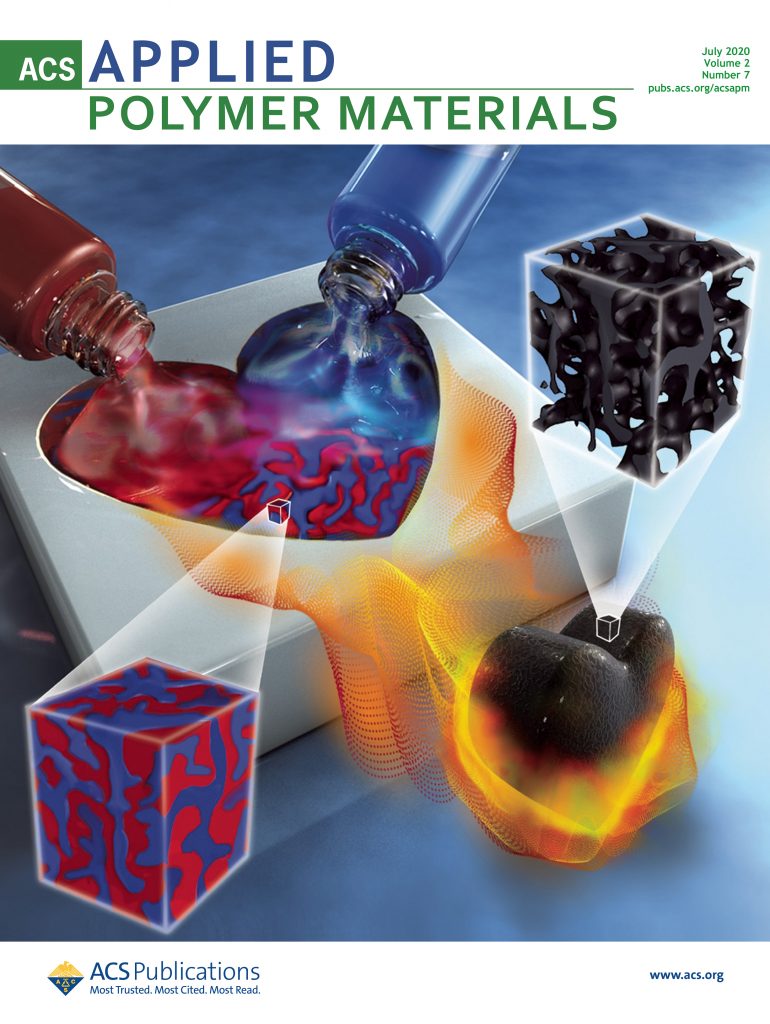Weak Polyelectrolyte Membranes with a Wide Ion-Exchange Capacity (IEC) Range and Limited Water Swelling in Clean Technologies for Sustainability
IF 4.4
2区 化学
Q2 MATERIALS SCIENCE, MULTIDISCIPLINARY
引用次数: 0
Abstract
Charged polymer membranes are of great interest in clean technologies for sustainability due to their tunable transport properties. Designing new innovative charged polymers for clean technologies is highly dependent on the mechanistic understanding of water and ion transport in these materials. In this context, we have designed a systematic library of weak polyelectrolyte membranes: cross-linked acrylic acid–poly(ethylene glycol) diacrylate (AA-PEGDA) networks, with a wide range of ion-exchange capacity (IEC = 0–4 mequiv/g) and limited water swelling (ϕW = 0.07–0.69). An acrylic acid (AA) monomer was chosen as a weakly charged group to control the charged group concentrations in the polymers, i.e., the maximum ion-exchange capacity (mIEC) at the varied external pH. Poly(ethylene glycol) diacrylates (PEGDAs) with different molecular weights were used as cross-linkers to control cross-linking densities in the networks. Specifically, in one fixed polymer composition, the charged (COO–) group concentration can be systematically changed on the same chemical structure by controlling the external pH: the same polymer behaves like an uncharged neutral polymer (the degree of ionization, α = 0) at low pH, whereas at pH = pKa, the same polymer is one-half charged (α = 0.5), and, at high pH (≫pKa), is fully charged (α = 1), providing extra freedom to tune IECs and an opportunity to investigate water and ion transport using the same chemical structure for the first time. The differences in polymer transport properties versus pH in the fixed chemical structure in this study can be achieved by substantially varying the chemical structure of other polymers in the literature. In addition to changing the chemical structure of polymers, this AA-PEGDA series can provide extra freedom to modify transport properties via simply changing the pH and enable us to develop a mechanistic understanding of water and ion transport in charged polymer membranes.

具有宽离子交换容量 (IEC) 范围和有限水膨胀性的弱聚电解质膜在可持续发展清洁技术中的应用
带电聚合物膜因其可调整的传输特性,在可持续发展的清洁技术领域引起了极大的兴趣。设计用于清洁技术的新型创新带电聚合物在很大程度上取决于对这些材料中水和离子传输机理的理解。在此背景下,我们设计了一个系统的弱聚电解质膜库:交联丙烯酸-聚(乙二醇)二丙烯酸酯(AA-PEGDA)网络,具有广泛的离子交换能力(IEC = 0-4 mequiv/g)和有限的水膨胀性(jW = 0.07-0.69)。选择丙烯酸(AA)单体作为弱带电基团,以控制聚合物中带电基团的浓度,即在不同外部 pH 值下的最大离子交换容量(mIEC)。不同分子量的聚乙二醇二丙烯酸酯(PEGDA)被用作交联剂,以控制网络中的交联密度。具体来说,在一种固定的聚合物成分中,通过控制外部 pH 值,可以系统地改变同一化学结构上的带电(COO-)基团浓度:在低 pH 值时,同一聚合物表现为不带电的中性聚合物(电离度 α = 0);而在 pH = pKa 值时,同一聚合物带电二分之一(α = 0.5),而在高 pH 值(≫pKa)时,则是完全带电(α = 1),这为调整 IEC 提供了更大的自由度,也为首次使用相同的化学结构研究水和离子的传输提供了机会。通过大幅改变文献中其他聚合物的化学结构,可以实现本研究中固定化学结构中聚合物传输特性与 pH 值的差异。除了改变聚合物的化学结构外,这种 AA-PEGDA 系列还能提供额外的自由度,通过简单地改变 pH 值来改变传输特性,使我们能够从机理上理解带电聚合物膜中水和离子的传输。
本文章由计算机程序翻译,如有差异,请以英文原文为准。
求助全文
约1分钟内获得全文
求助全文
来源期刊

ACS Applied Polymer Materials
Multiple-
CiteScore
7.20
自引率
6.00%
发文量
810
期刊介绍:
ACS Applied Polymer Materials is an interdisciplinary journal publishing original research covering all aspects of engineering, chemistry, physics, and biology relevant to applications of polymers.
The journal is devoted to reports of new and original experimental and theoretical research of an applied nature that integrates fundamental knowledge in the areas of materials, engineering, physics, bioscience, polymer science and chemistry into important polymer applications. The journal is specifically interested in work that addresses relationships among structure, processing, morphology, chemistry, properties, and function as well as work that provide insights into mechanisms critical to the performance of the polymer for applications.
文献相关原料
| 公司名称 | 产品信息 | 采购帮参考价格 |
|---|
 求助内容:
求助内容: 应助结果提醒方式:
应助结果提醒方式:


